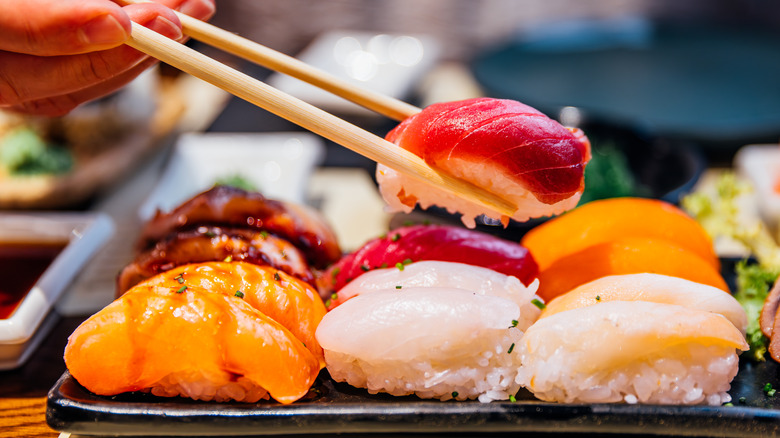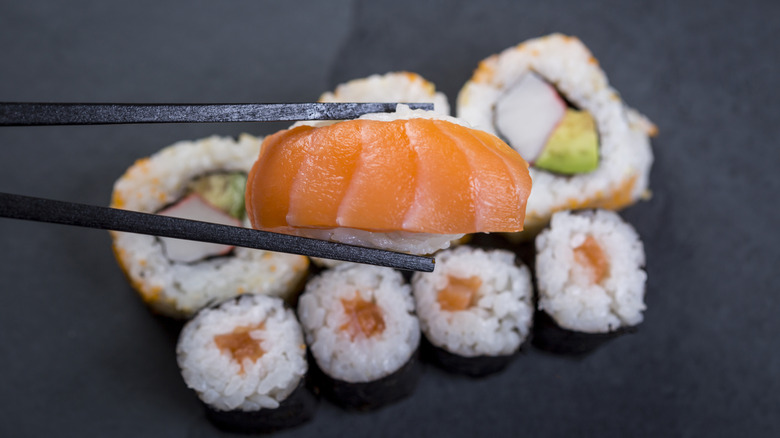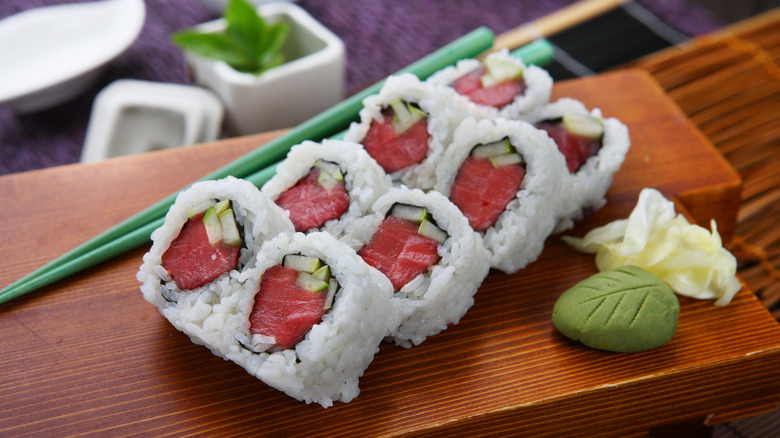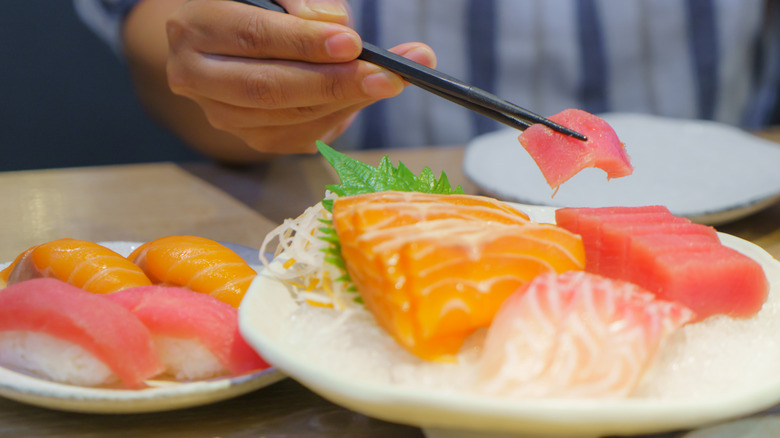Tuna Vs Salmon Sushi: The Subtle Differences In Taste And Texture
From grocery store California rolls to those artful, piled-high specialty rolls at your favorite sushi spot, sushi's variety is seemingly endless. But at the heart of even the most extravagant rolls, you'll usually find one of two star swimmers: tuna or salmon. These two fish are among the most popular choices for sushi lovers worldwide, and for good reason. They taste great, they're widely available, and they each bring something unique to the table (or rather, the sushi mat).
When you think of common sushi fish, crab might be the first to come to mind, but most of the crab used in sushi is actually imitation crab, since regular crab is less accessible and would be too expensive to use all the time. There's no imitation salmon or imitation tuna, though! Whether paired with avocado, cucumber, or even mango, both salmon and tuna offer delicious versatility. Yet, they've got to be at least a little different, so how do they really compare to one another? We'll break it down by taste, texture, smell, appearance, health benefits, and price.
What is salmon sushi?
Salmon sushi has skyrocketed in popularity over the years, especially in Western sushi culture. It's known for its buttery, rich taste and vibrant orange-pink color, often with delicate white marbling from fat. Unlike tuna, which has been a staple in Japan for centuries, salmon sushi was not traditionally eaten in Japan until the late 20th century when Norwegian exporters successfully introduced it to the Japanese market. Norway's overabundance of salmon led to the fish being easily available at cheaper sushi restaurants, helping drive its popularity.
Salmon is used in many forms in sushi, and it's one of the few fish that make up cooked sushi rolls. It's commonly served raw, smoked, and even lightly torched to enhance its natural oils and sweetness. It's a favorite for sushi beginners due to its mild, slightly sweet flavor and smooth texture. Common types of sushi-grade fish used in salmon sushi include sockeye and king salmon.
What is tuna sushi?
Tuna, known as "maguro" in Japanese cuisine, is a cornerstone of sushi. There are different types of tuna used in sushi, including lean akami, medium-fatty toro, and the ultra-rich, melt-in-your-mouth otoro, which comes from the belly of the fish. The fattier cuts are especially prized and can command sky-high prices at sushi restaurants. From albacore to bigeye tuna, different types may have varying fat content that can alter the way it tastes, like the difference between yellowfin and bluefin tuna. This flavor also affects what each part of the tuna is used for, such as with supermarket picks or sushi-train restaurant offerings.
Sushi has a deep, cultural significance in Japan, and tuna has been a part of it for many years. However, it wasn't until refrigeration and trend changes in the late 20th century that tuna became widely popular across the world for sushi. Whether enjoyed raw or seared, tuna's bold umami flavor makes it a favorite among sushi purists.
Taste and texture
Tuna and salmon offer two entirely different taste experiences, and which one you prefer might come down to how adventurous your palate is. Tuna has a bold, meaty depth that's packed with umami, making it feel almost steak-like in flavor. The leaner cuts, like akami (the deep red, muscular part of the fish), have an almost iron-rich quality that some compare to rare beef, while the fattier cuts, like otoro, which is cut from the belly, introduce an unctuous, melt-in-your-mouth sensation. Texturally, tuna is firmer and denser, with a satisfying chew that enhances its hearty profile.
Salmon, on the other hand, is more delicate and accessible in taste. It's slightly sweet, creamy, and far less intense than tuna, which makes it a favorite for sushi beginners. The high-fat content in salmon adds to its buttery nature, and when paired with something like soy sauce and wasabi, it takes on an almost silky richness. The key difference is intensity — tuna is robust and savory, while salmon is smooth and subtly sweet, with a tenderness that makes it incredibly easy to enjoy.
Smell and appearance
Both salmon and tuna are going to smell like fish — surprise! However, fresh sushi-grade fish should never have that strong, tangy fishy smell. If it does, something went wrong. That said, there are subtle differences in aroma between tuna and salmon. Tuna has a clean, briny scent that reminds you of the open ocean rather than a fish market. It's subtle, but if you take a deep inhale, you'll get a faint mineral-like smell, especially in leaner cuts. With salmon, though, you will get more of that strong fishy aroma, though it shouldn't smell bad.
Appearance-wise, tuna is striking with its range of colors, from deep ruby red in the leaner akami to pale pink in the fattier cuts. The more marbling, the lighter and more translucent the cut appears. Salmon is easily recognizable by its vibrant orange or pink hue, with thin white lines of fat running through it. Unlike tuna, salmon's marbling is more pronounced and creates a visually appealing contrast in each slice.
Health benefits
If you've heard that fish is brain food, that's because it's true. Both tuna and salmon are nutritional powerhouses, but they offer different benefits. Salmon is one of the best sources of omega-3 fatty acids, which are essential for brain function, heart health, and reducing inflammation. It's also packed with vitamin D, which supports bone health and immune function, as well as a solid amount of B vitamins for energy production.
Tuna, on the other hand, is higher in protein and lower in fat, making it a leaner choice for those looking to up their protein intake without consuming too much fat. However, fatty cuts of tuna, are rich in heart-healthy fats. Tuna is also a good source of Vitamin B12 and selenium, which is good for thyroid health, brain function, and metabolism. So, if your takeaway from this is that sushi is actually a health food, we won't disagree!
However, you've likely heard of people loading up on sushi only to suffer from mercury poisoning. Though you're likely safe if you eat in moderation, there is always a risk that the tuna you eat may have a high mercury content. Larger species, like bigeye, can accumulate higher levels of mercury, meaning they should be eaten in moderation. Salmon, particularly farmed varieties, can sometimes contain higher levels of contaminants, though sustainable sourcing practices are improving this issue.
Price
Price can play a factor in what fish you're picking out for your dinner. Tuna can cost more than salmon, especially high-end cuts like otoro. Different types of tuna vary in cost as well. High-end sushi restaurants often serve bluefin tuna, which is highly sought after but overfished and subject to quotas, making it scarce and expensive. The same goes for bigeye tuna, which is more commonly used, but still endangered, highly sought after, and pricey.
Unlike tuna, salmon is widely farmed, ensuring a stable supply and lower prices. Tuna requires special handling, auctions, and grading, which all add to the cost. Additionally, regional variations play a role, as high-quality tuna is considered a delicacy in Japan, whereas in Western markets, sustainably sourced salmon can sometimes be pricier. Regardless, tuna and salmon are here to stay as popular picks for topping sushi plates. What fish you go with ultimately depends on your preference for flavor, appearance, and price.






